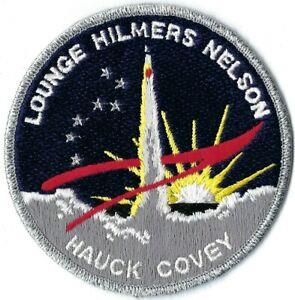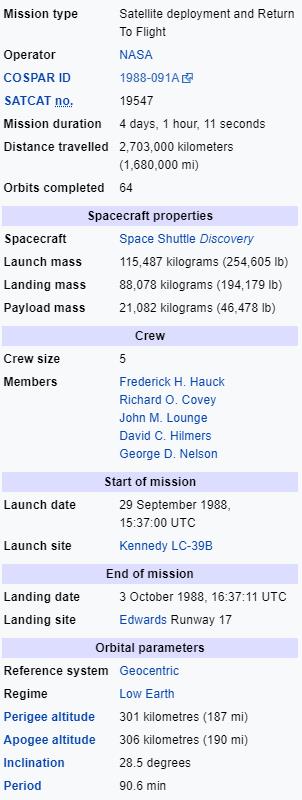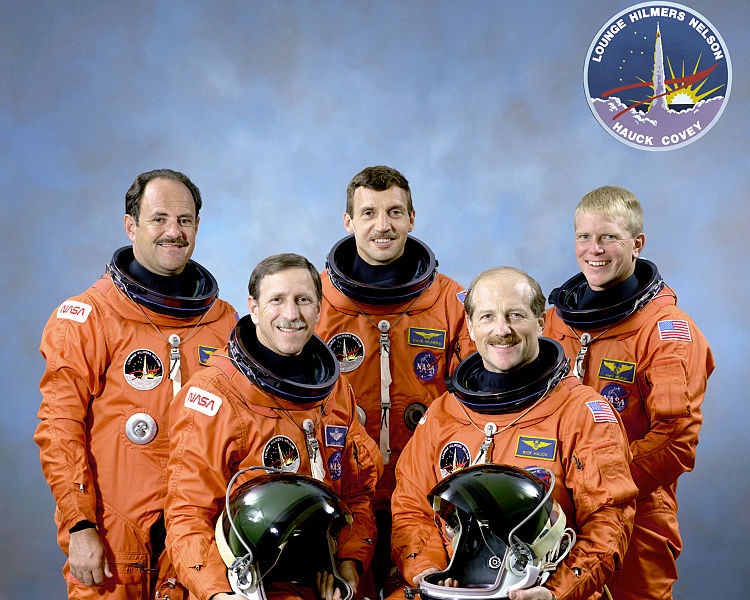Frederick H. Hauck
(Third Space Flight)
Pilot:
Richard O. Convey
(Second Space Flight) Mission Specialist 1:
John M. Lounge
(Second Space Flight) Mission Specialist 2:
George D. Nelson
(Third Space Flight) Mission Specialist 3:
David C. Hilmers
(Second Space Flight)
-
STS-26 was the 26th NASA Space Shuttle mission and the seventh flight of the Discovery orbiter. The mission launched from Kennedy Space Centre, Florida, on 29 September 1988, and landed four days later on 3 October. STS-26 was declared the "Return to Flight" mission, being the first mission after the Space Shuttle Challenger Disaster of 28 January 1986. It was the first mission since STS-9 to use the original STS numbering system, the first to have all its crew members wearing pressure suits for launch and landing since STS-4, and the first mission with bail-out capacity since STS-4. STS-26 was also the first all-veteran crew mission since Apollo 11, with all of its crew members having flown at least one prior mission.
Command Pilot:
Astronauts:
The Space Shuttle Missions
STS-26
Study
Research
Main Index
Space Cosmology
Science Research
*
About
Science Research
Science Theories
Desk
Site Map
BookShelf
Copyright © by Nigel G Wilcox · All Rights reserved · E-Mail: ngwilcox100@gmail.com
Designed by Nigel G Wilcox
Powered By AM3L1A
Pages within this section: USA Shuttle Mission Flights
STS-26
Pages within this section:
9
M
8
SM
Sub-Menu
menu
-
26
27
28
29
30
31
32


At T-1:30, it was proposed that the launch be delayed at T-0:31 due to a cabin air pressure issue. It was quickly determined that the cabin pressure had been increased slightly by the activation of the oxygen systems in the crew's flight suits, and the launch was conducted without further delay. The shuttle crew, all veteran astronauts, included Commander Frederick H. "Rick" Hauck, Pilot Richard O. Covey, and Mission Specialists John M. "Mike" Lounge, George D. "Pinky" Nelson and David C. Hilmers.
The primary payload for the STS-26 mission, a Tracking and Data Relay Satellite (TDRS), was successfully deployed, and 11 scheduled mid-deck scientific and technological experiments were carried out. The orbiter sustained only minor Thermal Protection System tile damage, and the redesigned post-Challenger solid rocket boosters showed no signs of leakage or overheating at any of the joints.
Two minor problems occurred during the flight. After ascent, the Flash Evaporator System for cooling the orbiter iced up and shut down, increasing the crew cabin temperature to approximately 87 °F (31 °C). The problem was resolved on Flight Day 4 and cooler temperatures resulted. A Ku-band antenna for communications was deployed on Flight Day 2, but it failed to respond properly and had to be stowed for the remainder of the mission.
During STS-26, Discovery became the first spacecraft to fly in space equipped with a VCU (Voice Control Unit), a computer capable of recognising and responding to human speech. The VCU was created by SCI Systems in Huntsville, Alabama, and was based on technology licensed from the Votan company. This speech recognition system controlled the cameras and monitors that were used by the crew to monitor the Canadarm mechanical arm mounted in the cargo bay. Because of the experimental nature of speech recognition at the time, this system was not used for any critical operations. Initial problems almost sidelined the tests when the voice templates that were created prior to liftoff were found to have less than 60% recognition for one crew member and less than 40% recognition for another. This problem was corrected by retraining the templates. It was retested and found to be operational with a recognition success rate of over 96%. It was concluded that weightless conditions caused a fundamental change in human speech, making the templates created prior to liftoff virtually useless.
Besides conducting the mission's various experiments, crew members practiced suiting up in new partial-pressure "launch-and-entry" flight suits, and also practiced the unstowing and attaching of the new crew escape system. On 2 October, the day before the mission ended, the five-man crew paid tribute to the seven crew members lost in the Challenger disaster.
Discovery landed on Runway 17, Edwards Air Force Base, California, at 12:37 pm EDT on 3 October 1988, after a mission duration of approximately 4 days and 1 hour. Capsule Communicator Blaine Hammond Jr. welcomed the crew, saying it was "a great ending to a new beginning."
Space Shuttle Discovery lifted off from Pad B, Launch Complex 39, Kennedy Space Center, at 11:37 am EDT on 29 September 1988, 975 days after the Challenger disaster. The launch was delayed by one hour and 38 minutes due to unseasonable and unusual light winds, and the need to replace fuses in the cooling systems of two crew members' flight suits. The suits were repaired, and a waiver was issued for the wind conditions after officials determined there was a sufficient safety margin for wind loads on the orbiter's wing leading edges.
Data Courtesy Wikipedia.org












